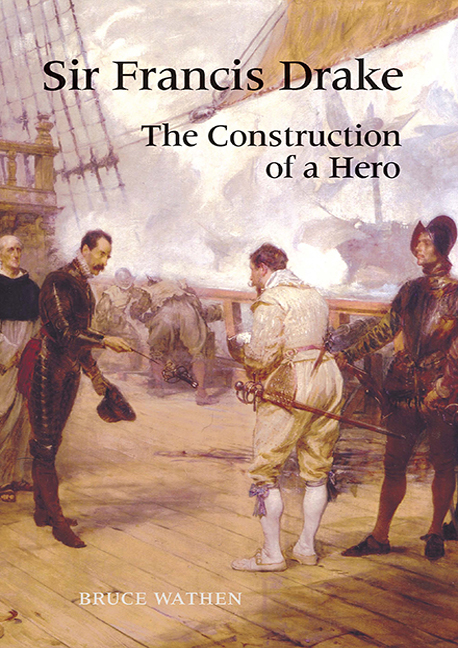Book contents
- Frontmatter
- Contents
- List of Illustrations
- Dedication
- Acknowledgements
- Introduction
- Chapter One Auxilio Divino
- Chapter Two ‘Sir Francis Drake Revived’
- Chapter Three ‘Behold the warrior dwindled to a beau’
- Chapter Four ‘Homage to Britannia’
- Chapter Five ‘Who the New World Bade British Thunders Shake?’
- Chapter Six ‘The Prose Epic of England’
- Chapter Seven ‘Mould him in bronze’
- Chapter Eight ‘Gun to Gun he'll Challenge us’
- Chapter Nine ‘A pirate, and a good one’
- Chapter Ten The Future
- Bibliography
- Index
Chapter Two - ‘Sir Francis Drake Revived’
Published online by Cambridge University Press: 11 May 2017
- Frontmatter
- Contents
- List of Illustrations
- Dedication
- Acknowledgements
- Introduction
- Chapter One Auxilio Divino
- Chapter Two ‘Sir Francis Drake Revived’
- Chapter Three ‘Behold the warrior dwindled to a beau’
- Chapter Four ‘Homage to Britannia’
- Chapter Five ‘Who the New World Bade British Thunders Shake?’
- Chapter Six ‘The Prose Epic of England’
- Chapter Seven ‘Mould him in bronze’
- Chapter Eight ‘Gun to Gun he'll Challenge us’
- Chapter Nine ‘A pirate, and a good one’
- Chapter Ten The Future
- Bibliography
- Index
Summary
‘Recommended as an Excellent Example
to all Heroick and Active Spirits.’
(Robert Burton, The English Hero, 1687)
The celebration of Drake in print during the seventeenth century was far more fulsome than anything that had appeared while Sir Francis was still alive. Material was also far more plentiful. But there were also periods when the production of Drake- related material dried up; these lacunae are as revealing as the cultural products themselves and suggest that far from acting as a simple signifier of English military prowess, the revival of Sir Francis was a complex and politically loaded activity.
The popular cultural construction of Drake as the hero of the Armada conflict, first seen in popular ballads, re-emerges in Thomas Heywood's play If You Know Not Me,You Know Nobody.The Second Part.This work was first performed in 1606 and appeared in numerous versions, the final in 1632.The bulk of the play is a comedy concerned with Thomas Gresham's building of the Royal Exchange, but a final patriotic section is devoted to the defeat of the Spanish Armada.This section may seem entirely unrelated until we realize that during the spring and summer of 1588 192 merchant ships were mobilized in defence of the nation. London merchants were also an important source of loans to the government. In Heywood's play a merchant named Hobson tells the queen,‘When thou seest money with thy grace is scant,/ For twice fiue hundred pound thou shalt not want.’ Noticeably, Drake's part in the defeat of the Armada is enhanced in the later edition. In the 1606 version the queen anxiously awaits the news of the sea-fight off Calais. She receives a reassuring message:
… the vndaunted worth
And well known valour of your Admirall,
Sir Francis Drake, and Sir Martin Furbisher,
Gives vs assured hope of victory.
But almost immediately this confidence is shattered; a second messenger relates the details of Martin Frobisher's desperate clash with the Spanish off the Isle of Wight. Moved by the description of his furious defence, the queen prepares to lead her troops into battle but as they march about the stage Sir Francis Drake enters with Spanish flags ‘… to shew that Spaniards liues are in the hands/ Of England's soueraign’.
- Type
- Chapter
- Information
- Sir Francis DrakeThe Construction of a Hero, pp. 33 - 47Publisher: Boydell & BrewerPrint publication year: 2009

